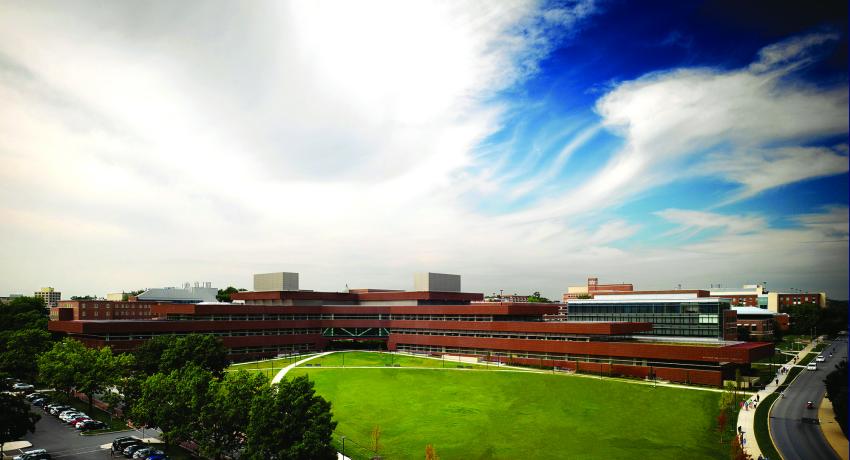The Millennium Science Complex at Penn State University which is the home of the Materials Characterization Lab (MCL), the Nanofabrication Lab, and the Two-Dimensional Crystal Consortium-Materials Innovation Platform (2DCC-MIP) - Materials Research Institute's core facilities. Credit: Penn State/MRI
By Jamie Oberdick
In the heart of Penn State’s University Park campus stands the Millennium Science Complex (MSC), a striking architectural feat that houses the Materials Research Institute (MRI). Beyond its impressive facade, the MSC is a hub of scientific discovery, education, and collaboration, embodying the University’s commitment to advancing materials science for the greater good.
At MRI, research facilities are more than just rooms filled with instruments; they are dynamic ecosystems led by innovative minds where game-changing progress and invention thrive. The Materials Characterization Lab (MCL), the Nanofabrication Lab, and the Two-Dimensional Crystal Consortium-Materials Innovation Platform (2DCC-MIP) are core facilities that exemplify this ethos. These facilities are led by experienced researchers such as the 2DCC-MIP’s Joan Redwing, a leading expert in semiconductor materials; the MCL’s Joshua Stapleton, an expert in advanced materials analysis; and the Nanofab’s Daniel Lopez, a leader in nanoscale device engineering and fabrication.
While MRI research happens at other facilities across the University, these labs are the heart of the institute. They provide researchers with access to state-of-the-art equipment and expert staff, enabling groundbreaking work in Facilities (and the people using them) drive innovation at Penn State semiconductors, nanotechnology, and advanced materials.
The MCL offers a suite of advanced analytical tools, including scanning electron microscopy and X-ray photoelectron spectroscopy, facilitating detailed material analyses. The Nanofabrication Lab provides capabilities in deposition, etching, and lithography, supporting the creation of novel devices and structures. Meanwhile, the 2DCC-MIP focuses on the synthesis and characterization of two-dimensional materials, fostering innovation in electronics and flexible devices.
These facilities are not only centers of research but also integral to education and workforce development. Students at all levels engage directly with cutting-edge equipment, gaining hands-on experience that prepares them for careers in industry and academia. This approach aligns with Penn State’s land-grant mission, emphasizing practical education and public service. It is worth noting that while the research itself at MRI, and at Penn State in general, has enormous value to our society it also trains graduates to make even more beneficial breakthroughs at wherever their careers take them.
Industry partnerships further amplify MRI’s impact. Collaborations with companies like Morgan Advanced Materials and onsemi have led to the establishment of initiatives such as the Silicon Carbide Innovation Alliance (SCIA). The SCIA aims to advance U.S. silicon carbide technology and workforce development, positioning Penn State as a central hub for research and training in this critical area.
The success of MRI’s facilities is also a testament to the dedicated staff who manage and maintain them. Facilities manager Sarah Eichfeld and her team ensure that the MSC operates seamlessly, supporting researchers’ needs and maintaining the building’s specialized features, such as vibration-minimized “quiet labs.” Their work enables scientists to focus on discovery without interruption.
As Penn State continues to expand its research capabilities, initiatives like the cleanroom expansion across campus to demonstrate a commitment to staying at the forefront of materials science. These developments not only enhance research opportunities but also reinforce the university’s role in driving innovation and economic growth.
Read more about MRI's core facilities in our latest magazine, Focus on Materials, where we delve deeper into the stories of Penn State’s research facilities, exploring how they serve as both the physical and intellectual infrastructure of modern materials science. From fostering student engagement to enabling industry collaborations, these facilities are at the core of transformative research and education.


